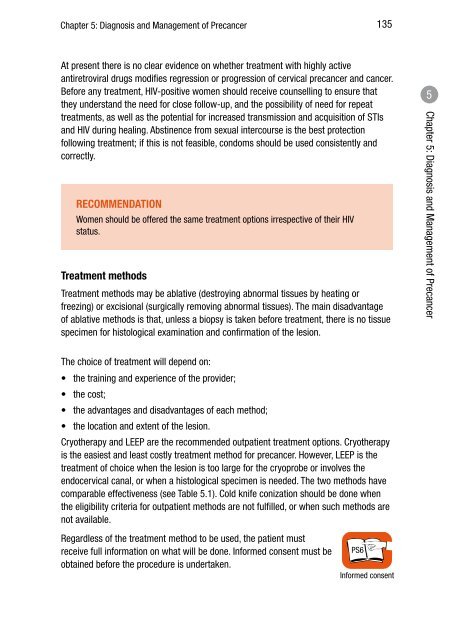CHAPTER 4: SCREENING FOR CERVICAL CANCER
CHAPTER 4: SCREENING FOR CERVICAL CANCER
CHAPTER 4: SCREENING FOR CERVICAL CANCER
Create successful ePaper yourself
Turn your PDF publications into a flip-book with our unique Google optimized e-Paper software.
Chapter 5: Diagnosis and Management of Precancer 135At present there is no clear evidence on whether treatment with highly activeantiretroviral drugs modifies regression or progression of cervical precancer and cancer.Before any treatment, HIV-positive women should receive counselling to ensure thatthey understand the need for close follow-up, and the possibility of need for repeattreatments, as well as the potential for increased transmission and acquisition of STIsand HIV during healing. Abstinence from sexual intercourse is the best protectionfollowing treatment; if this is not feasible, condoms should be used consistently andcorrectly.RECOMMENDATIONWomen should be offered the same treatment options irrespective of their HIVstatus.Treatment methodsTreatment methods may be ablative (destroying abnormal tissues by heating orfreezing) or excisional (surgically removing abnormal tissues). The main disadvantageof ablative methods is that, unless a biopsy is taken before treatment, there is no tissuespecimen for histological examination and confirmation of the lesion.5Chapter 5: Diagnosis and Management of PrecancerThe choice of treatment will depend on:• the training and experience of the provider;• the cost;• the advantages and disadvantages of each method;• the location and extent of the lesion.Cryotherapy and LEEP are the recommended outpatient treatment options. Cryotherapyis the easiest and least costly treatment method for precancer. However, LEEP is thetreatment of choice when the lesion is too large for the cryoprobe or involves theendocervical canal, or when a histological specimen is needed. The two methods havecomparable effectiveness (see Table 5.1). Cold knife conization should be done whenthe eligibility criteria for outpatient methods are not fulfilled, or when such methods arenot available.Regardless of the treatment method to be used, the patient mustreceive full information on what will be done. Informed consent must beobtained before the procedure is undertaken.PS6Informed consent
















